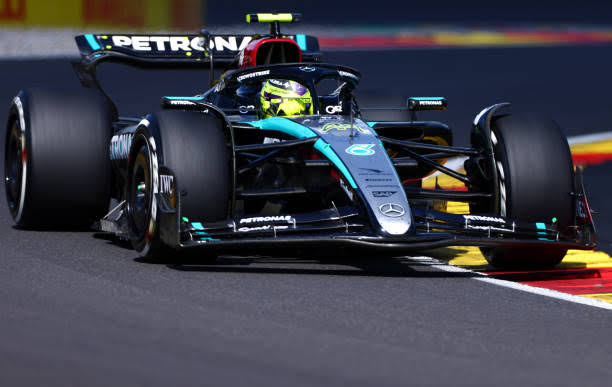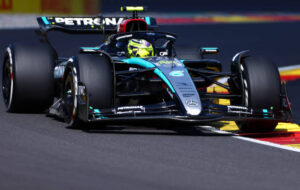
Hamilton’s driving style is known for its smoothness and ability to extract the maximum performance from the car over long stints.

Mercedes has provided an explanation for why Lewis Hamilton has seen more significant benefits from the upgrades to the W15 compared to his teammate, George Russell. This situation revolves around several key factors, including the car’s setup preferences, driving styles, and feedback integration.
1. Car Setup and Driving Style:
One of the primary reasons Hamilton has benefited more from the W15 upgrades is his distinct driving style and how it aligns with the car’s setup. Hamilton’s driving style is known for its smoothness and ability to extract the maximum performance from the car over long stints. This style suits the characteristics of the W15 upgrades, which include improvements to the aerodynamics and balance of the car. These upgrades likely enhance stability and responsiveness, areas where Hamilton’s driving style excels. In contrast, Russell’s driving approach, which might be more aggressive or tuned towards different car behaviors, may not align as well with these specific improvements.
2. Experience and Feedback:
Hamilton’s extensive experience in Formula 1 allows him to provide highly valuable feedback on car upgrades. His deep understanding of car dynamics and extensive historical knowledge of how different setups affect performance means that he can make the most of new developments. When Mercedes introduced the W15 upgrades, Hamilton’s feedback helped fine-tune the car’s setup to optimize the benefits of these changes. Russell, being less experienced compared to Hamilton, may not have been able to utilize the upgrades to their fullest potential immediately. The iterative process of car development often benefits more seasoned drivers who can quickly adapt and offer precise feedback.
3. Development and Adaptation:
The W15 upgrades were likely designed to address specific performance gaps or to enhance certain aspects of the car. Hamilton’s ability to adapt to these upgrades more quickly and effectively could be due to his familiarity with Mercedes’ car development process. Over the years, Hamilton has developed a profound understanding of how to maximize the benefits of new components and changes. As a result, he has been able to integrate the W15 upgrades into his driving more seamlessly. Russell, while highly skilled, may need more time to adapt to these changes fully.
4. Strategic Influence:
Hamilton’s strategic input and influence within the team also play a role. Given his status as a multiple-time world champion, Hamilton’s opinions and preferences may carry more weight within the team’s development discussions. This could lead to a more personalized approach to fine-tuning the W15 to better suit Hamilton’s driving preferences, thereby amplifying the benefits he derives from the upgrades.
5. Team Dynamics and Adaptation:
Mercedes’ approach to adapting the W15 upgrades might also reflect the team’s strategy to optimize performance for their most experienced driver. Teams often tailor their car development and setup adjustments to suit their lead driver’s strengths, especially when that driver has a proven track record of performance. In this case, Mercedes might have prioritized optimizing the W15 for Hamilton’s style and strengths, resulting in him benefiting more from the upgrades.
6. Data and Analysis:
Data analysis from the initial runs with the W15 upgrades could show that Hamilton’s performance metrics align more closely with the intended outcomes of the upgrades. If the data indicates that Hamilton’s driving style maximizes the benefits of the new features, the team might focus on fine-tuning the car further in that direction. Russell’s performance data might not have shown the same level of alignment, resulting in a slower realization of benefits.
In summary, the disparity in the benefits derived from the W15 upgrades between Hamilton and Russell is attributed to a combination of factors including driving style, experience, feedback, and strategic considerations within the team. Hamilton’s alignment with the upgrades and his ability to leverage them effectively showcase the complex interplay between driver characteristics and car development. As the season progresses, further developments and adjustments could potentially help Russell tap into the upgrades’ benefits more fully.







